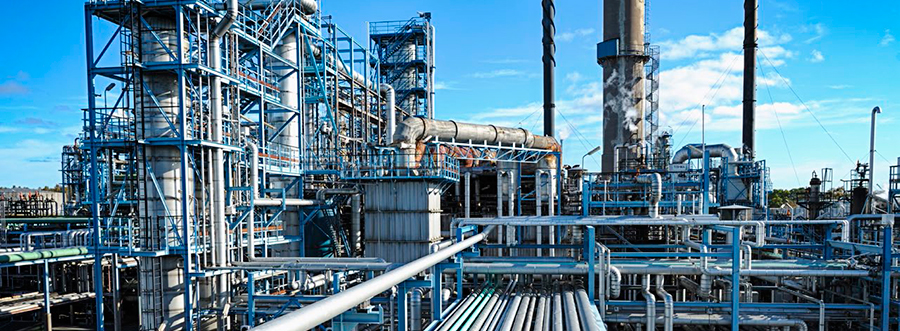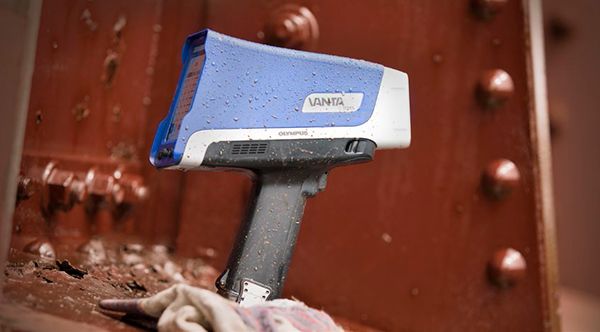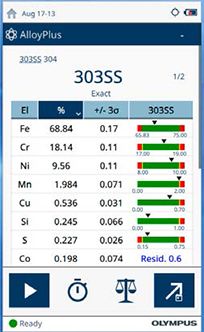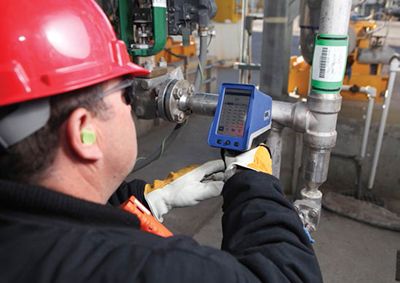
In the oil and gas, chemical, and power generation industries, preventing leaks and spillages caused by component failure is of vital importance. A reliable and comprehensive positive material identification (PMI) program is an essential element to ensuring safe plant operation. Handheld X-ray fluorescence (XRF) analyzers are well suited for fast, easy PMI measurements, providing a cost-effective way to prevent component failures and maintain plant safety.
The key to running a successful PMI program is adjusting for the specific challenges of the industry. In the oil and gas industry, harsh conditions and the resulting risks of damage are important challenges for inspection equipment. Furthermore, due to the scale of a typical plant, traceability and short measurement times—without compromising on reliability—are also critical for success.
Instant Grade and Composition Identification
In the oil and gas industry, pipes, solder, welds, connectors, and screws all have to be made of the correct alloy for their application. Due to high temperatures , high pressures, mechanical stresses, and corrosive substances, use of the wrong type of alloy in one component can jeopardize the safety of an entire pipeline or vessel. In a comprehensive PMI program, all these components are tested before operation and as part of in-service inspections or when needed—for example in the case of a missing certificate. With the use of XRF technology (Figure 1), this type of alloy identification can be carried out in seconds. XRF spectra reveal the relative abundances of metals, which are then automatically checked against a preloaded library of alloys and grades. This approach enables fast decision making and saves time on PMI inspections. |
The sensitivity of XRF analyzers also makes them well suited for detecting trace elements. This feature enables XRF analyzers to be used in other applications such as corrosion inspection. For example, the presence of trace elements such as chromium (Cr), nickel (Ni), and copper (Cu) in carbon steel can indicate corrosion in hydrofluoric (HF) alkylation units, or carbon steel with low (Si) content can exhibit significant accelerated/non-uniform corrosion due to the known sulfidation corrosion process.
 Figure 2—The Vanta XRF analyser is designed for harsh industrial conditions. |  Figure 3—The Vanta analyzer’s precise, reliable readouts make it easy to determine the composition of an alloy. |
Traceability and Reliable Report Generation
A key challenge in the inspection of large plants and structures (such as long pipelines) is the traceability of measurements. Even when measurement results are generated quickly, collating the data into detailed reports can make PMI inspections laborious and time-consuming. The large number of measurements involved also increases the risk of human errors in report generation.
Advanced XRF analyzers are equipped with GPS, wireless connectivity, Bluetooth®, and cloud storage to simplify the creation of inspection reports and improve measurement traceability. The combination of GPS and timestamping of all measurements saves time on reporting and reduces the risk of errors and easy internet access enables automated data sharing and archiving.
Dealing with the Elements
The working conditions on industrial plants are often tough for inspection equipment. Damage due to water, dust, drops, or shocks is highly likely when unsuitable equipment is used. Also, due to the layout of a plant, it is often necessary to inspect in hard-to-access locations.
Designed for portability and damage resistance, XRF analyzers are well equipped to handle the harsh conditions of oil and gas plants. The devices are lightweight and can be carried in one hand, or stored in a holster and worn on a belt. Additional features such IP ratings, a design made to pass a drop test, detector shutter protection, and cooling fans make XRF analyzers highly suitable for in-service testing.
Designed for Industry
Olympus’ Vanta XRF analyzers (Figure 2) fulfill the requirements for a reliable, efficient PMI program in oil and gas plants. The analyzer’s drop-tested, rugged design and IP64/ 65 rating improve your return on investment by reducing the risk of damage. These features, combined with fast results that are both accurate and repeatable (Figure 3), underline its suitability for a PMI program that helps to avoid part failures and ensure plant safety and profitability.
Vanta XRF Analyzer Bundles
PMI BundleVanta VCR model with a rhodium X-ray tube, aiming camera, beam collimation, 5-megapixel sample camera, preinstalled cooling fan, belt holster, wireless connectivity dongle, and 3 CRMs for QC/QA testing and documentation. | Hot Surface BundleVanta VMR model with rhodium X-ray tube, aiming camera, beam collimation, 5-megapixel sample camera, preinstalled cooling fan, belt holster, wireless connectivity dongle, and hot alloy surface kit for detecting low concentrations of Si, Cr, Ni, Cu, and other elements in hot steel tubes. |


